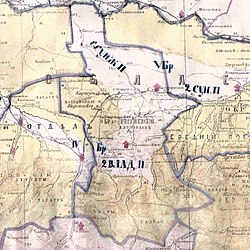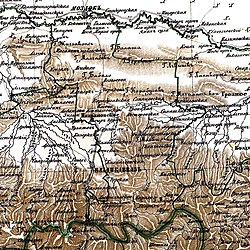Sagopshi is a rural locality in Malgobeksky District of the Republic of Ingushetia, Russia. Population: 10,048 (2010 Russian census); 10,738 (2002 Census).
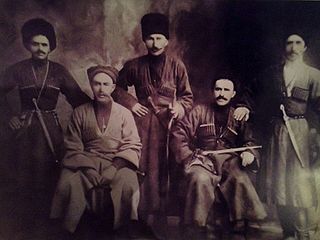
The Orstkhoy, historically commonly known under their exonyms: Karabulaks, Balsu, Baloy, are a historical ethnoterritorial society among the Chechen and Ingush peoples. Their homeland is in the upper reaches of the Assa and Fortanga rivers in the historical region of Orstkhoy-Mokhk. In the tradition of the Chechen ethno-hierarchy, it is considered one of the nine historical Chechen tukkhums, in the Ingush tradition as one of the seven historical Ingush shahars.
Galashki is a rural locality in Sunzhensky District of the Republic of Ingushetia, Russia, located on the left bank of the Sunzha River near the border with the Republic of North Ossetia–Alania. Its population was about 9,000 people in 2009. Galashki forms the municipality of the rural settlement of Galashki as the only settlement in its composition.
Bamut is a non-residential rural locality in Sernovodsky District of the Republic of Chechnya, Russia. From 1922 to 1934, Bamut was a part of the Ingush Autonomous Oblast.
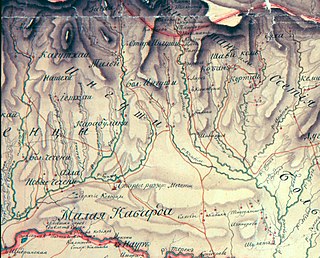
The Act of oath of six Ingush clans to Russia was a treaty between ten representatives of six major Ingush clans (teips) and the Russian Empire. It was signed on August 22, 1810 in the city of Vladikavkaz. Due to this oath, the Ingush were given the right to settle the land along the right bank of the Terek up to the ridge.
Ingush societies or shahars were ethnoterritorial associations of the Ingush based on the geographical association of several villages and intended for conditional administrative-territorial delimitation of the Ingush ethnic group. The formation and functioning of most of them dates back to the late Middle Ages. During this period, their boundaries, number and names changed.
Tyarsh or Tarsh, is an aul in the Dzheyrakhsky District of Ingushetia. It is part of the rural settlement of Olgeti. Tyarsh is the ancestral aul of Ingush teip Torshkhoy.
Muzhichi is a rural locality in Sunzhensky District of the Republic of Ingushetia, Russia, located on the left bank of the Sunzha River near the border with the Republic of North Ossetia–Alania. It forms the municipality of the rural settlement of Muzhichi as the only settlement in its composition.

Yandare is a rural locality in Nazranovsky District of the Republic of Ingushetia, Russia. It forms the municipality of the rural settlement of Yandare as the only settlement in its composition.
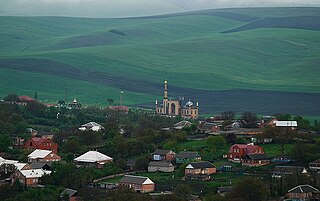
Ekazhevo is a rural locality in Nazranovsky District of the Republic of Ingushetia, Russia. It forms the municipality of the rural settlement of Ekazhevo as the only settlement in its composition.

Barsuki is a rural locality in Nazranovsky District of the Republic of Ingushetia, Russia. It forms the municipality of the rural settlement of Barsuki as the only settlement in its composition.

Plievo is a rural locality in Nazranovsky District of the Republic of Ingushetia, Russia. It forms the municipality of the rural settlement of Plievo as the only settlement in its composition.

Surkhakhi is a rural locality in Nazranovsky District of the Republic of Ingushetia, Russia. It forms the municipality of the rural settlement of Surkhakhi as the only settlement in its composition.
Dattykh is a rural locality in Sunzhensky District of the Republic of Ingushetia, Russia, located on the left bank of the river Fortanga. It forms the municipality of the rural settlement of Dattykh as the only settlement in its composition.

Fortanga historically sometimes referred as Balsu, is a river in North Caucasus that flows in Ingushetia and Chechnya. The length of the river is 69 km, the basin area is 526 km2.

Vilayet Arshtkhoy,Vilayet Arshty,Arshtinskiy Vilayet, was an Ingush administrative unit of the North Caucasian Imamate. The Naibstvo was the farthest region of the Imamate in the west and it was established on the territory of Orstkhoy society with the center being the village of Arshty.
Psedakh is a rural locality in the Malgobeksky District of the Republic of Ingushetia, Russia. It forms the municipality of the rural settlement of Psedakh as the only settlement in its composition.

Targim is an ancient city-settlement in the Dzheyrakhsky District of Ingushetia. It is part of the rural settlement of Guli. The entire territory of the settlement is included in the Dzheyrakh-Assa State Historical-Architectural and Natural Museum-Reserve and is under state protection.

Metskhal is an abandoned aul in the Dzheyrakhsky District of Ingushetia. It is part of the rural settlement of Lyazhgi.
Gandalbos is rural locality in Sunzhensky District of the Republic of Ingushetia, Russia, located on the left bank of the river Fortanga. It is part of the municipality of the rural settlement of Dattykh.



